
Originally published in the Slide Rule Gazette, Issue 10, Autumn 2009
I first became aware of these interesting scales from W F Stanley’s 1912 catalogue (ref. 1) and my interest was re-awakened when I won on eBay a Hudson’s Pump Duty Computing Scale. Returning to the 1912 Stanley catalogue, three Hudson’s were listed, the Horsepower Computing Scale, the Pump Scale and a Shaft, Beam & Girder Scale. However Peter Hopp (ref. 2) lists a fourth; this, the Photo Exposure Scale, did not appear in any of my catalogues but I eventually found it in a W F Stanley advert in the back of the 1903 edition of Pickworth (ref. 3). Of these scales then, several examples of the Horsepower Computing Scale exist and I have some scans by the late Michael O’Leary, courtesy of Clark McCoy, and also by Ray Hems, and I have my own example of the Pump Computing Scale. The books and catalogues of the time describe the Shaft, Beam & Girder Scale although I have not located an extant example, but the Photo Exposure Scale is known at present by its name only. The scales were designed by J G Hudson, CE and made by W F Stanley.
Hudson’s Pump Duty Computing Scale
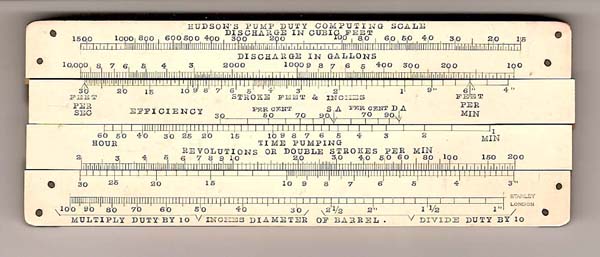
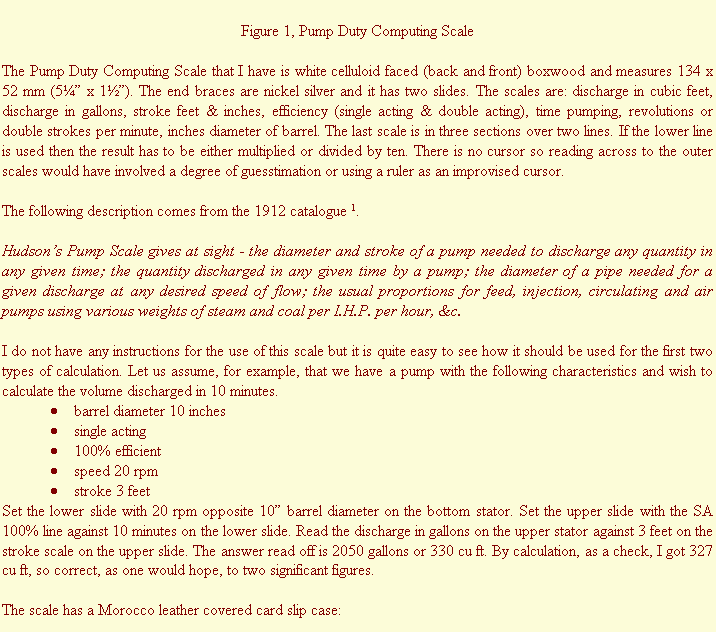
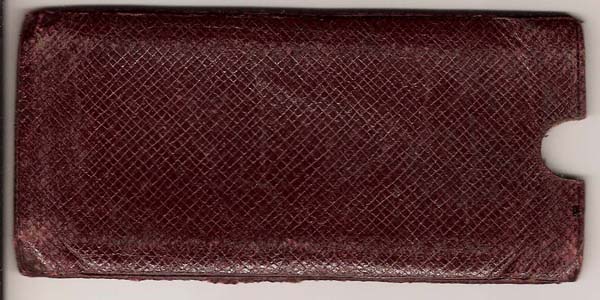
Figure 2, Pump Scale Case
I have been trying to find out when production started and ended for each of these computing scales. The earliest reference known to date for the pump duty scale is the 1890 edition of W F Stanley’s ‘Surveying & Levelling Instruments’ (ref. 4). It is described in the 1900 edition of W F Stanley’s ‘Mathematical Drawing Instruments’ (ref. 5) and listed in the 1912 W F Stanley catalogue (ref. 1). It does not appear in either the 1888 edition of W F Stanley’s ‘Mathematical Drawing Instruments’ (ref. 6) or the 1916 A G Thornton catalogue (ref. 7) although both of these list the HP computing scale.
Like the other computing scales this was made in a variety of materials:
Card in case 1890 1898 6/- 1900 6/-
1912 5/- 1918 8/4
1912 5/-
Opaque celluloid 1912 14/- 1918 £1 3s 4d
Celluloid faced boxwood Not found in a catalogue so far
In 1912 they could be had for 1/- less without a case. In the 1918 list of revised prices all slide rule prices were advanced by 66 2/3% implying that Pump Duty rules were still available then since non-available items from the 1912 catalogue were noted. They did not appear in the 1924 catalogue.
Hudson’s Horsepower Computing Scale

Figure 3, Horse Power Computing Scale (courtesy Ray Hems)

Figure 4, Horse Power Computing Scale, reverse (Ray Hems)
Figures 3 and 4 show an ivory example of the Horse Power Computing Scale. Detailed instructions for its use were given in the 1878 edition of W F Stanley’s ‘Mathematical Drawing Instruments’ (ref. 8):
To find Power of Engine, - Set the “Mean Pressure” on lower slide against the “Cylinder Diameter,” and retaining it in this position, bring the “Revolutions” on upper slide, opposite the “Stroke” (or the “Piston Speed” opposite the small arrow); the large arrow will then point to the “Power.”
To find Size of Engine, - Set the large arrow on upper slide against the “Power” desired, and retaining it in this position, bring the “Stroke” on lower slide opposite the “Revolutions” (or the small arrow opposite the “Piston Speed”); the “Mean Pressure” will then be against the size of cylinder necessary.
To find Piston Speed,- Set the “Stroke” against the “Revolutions” and the small arrow will point to the “Piston Speed.”
Mean Pressure Scale (on back) shows what proportion of initial is realised as mean pressure, with cut-off at different percentages of stroke. For a Compound Engine (with two or more cylinders), set the number on “Mean Pressure” slide representing the percentage of cut-off in smallest cylinder, against the diameter of that cylinder, and use the number then found opposite diameter of largest cylinder as the cut-off for the latter working by itself, to give power equal to that from the compound cylinders.
Ratio of Compound Cylinders, - Set the 1 on “Mean Pressure” slide against the diameter of L.P. cylinder, the ratio will then be opposite that of H.P. cylinder.
These instructions were also included on a card supplied with the rules. There were further instructions on the rule itself. Most of the earlier W F Stanley books and catalogues referenced included the following illustration of the HP Computing Scale:
To find Power of Engine, -
To find Size of Engine, -
To find Piston Speed,-
Mean Pressure Scale (on back) shows what proportion of initial is realised as mean pressure, with cut-
Ratio of Compound Cylinders, -
These instructions were also included on a card supplied with the rules. There were further instructions on the rule itself. Most of the earlier W F Stanley books and catalogues referenced included the following illustration of the HP Computing Scale:
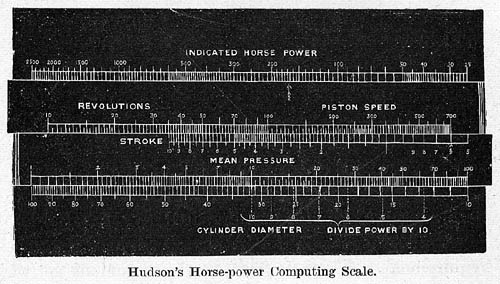
Figure 5
The Horse Power Computing Scale also appeared in Keuffel & Esser Catalogues in the USA at least from 1901 to 1916. The following example is from the 1913 edition (ref. 11).
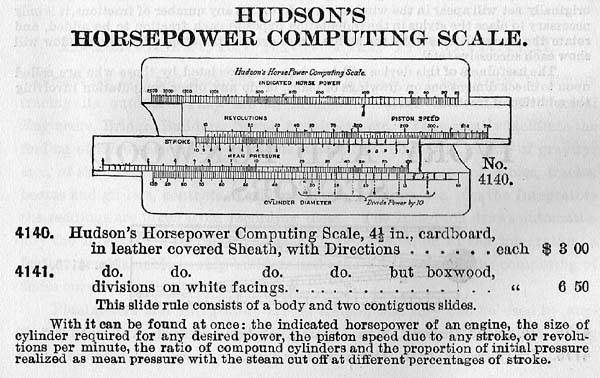
Figure 6, 1913 K&E Catalogue
The illustration in figure 6 is an accurate representation of the card version. Figures 7 and 8 are scans of the cardboard and boxwood versions respectively. Note that the boxwood version does not have the white facings listed in the K&E catalogue, although both of these examples are from America, scanned by the late Michael O’Leary, and sold by K&E. The boxwood one is stamped Stanley London and the card one has Entd at Stationer’s Hall on it. Clearly K&E imported them from W F Stanley.
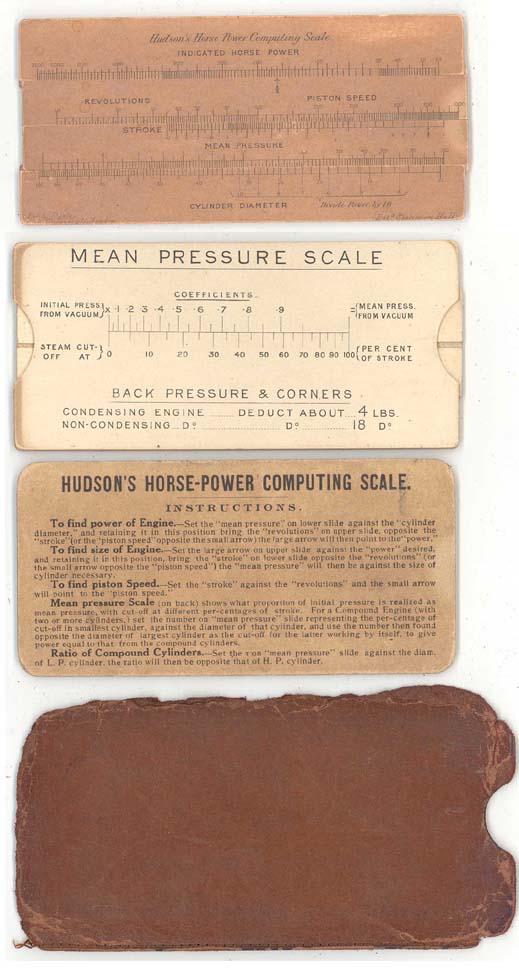
Figure 7, K&E 4140
Cardboard Hudson’s Horse Power Computing Scale (Michael O’Leary)
Cardboard Hudson’s Horse Power Computing Scale (Michael O’Leary)
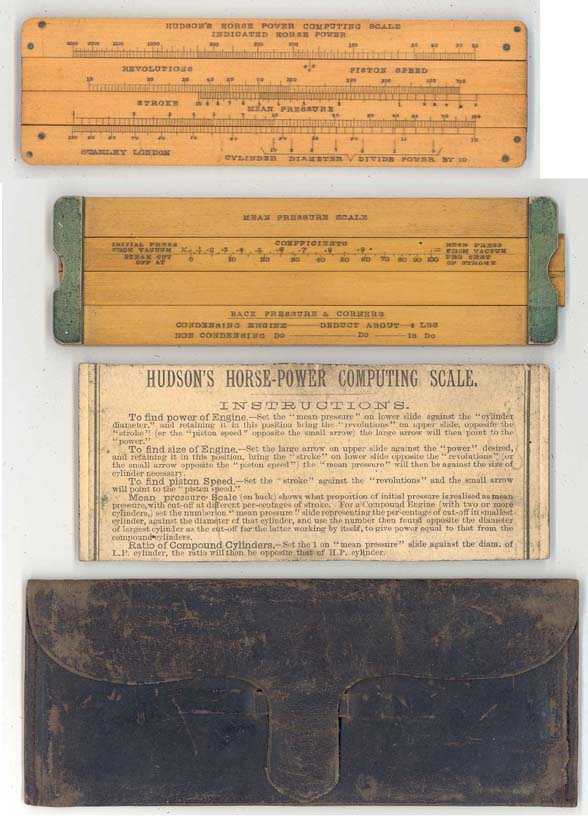
Figure 8, K&E 4141
Boxwood Hudson’s Horse Power Computing Scale (Michael O’Leary)
I am not sure whether the case in this instance was made by Stanley or K&E as I have seen another example of this boxwood rule on UK eBay which had a Morocco slip case, similar to that for my Pump Duty Computing Scale. However it may have been a later example as it had the Stanley trade mark on it rather than just Stanley London.
Whilst Hudson’s Horse Power Computing Scales were only catalogued by K&E from 1901 to 1916 (ref. 9), the first reference to them that I have found by W F Stanley is the 1878 edition of his book (ref. 8) and the last is the 1931 W F Stanley catalogue (ref. 10). It is clear that the reason why more HP computing scales seem to have survived than any of the others is because they were made over a far longer period and were sold by other firms such as K&E and A G Thornton.
Whilst Hudson’s Horse Power Computing Scales were only catalogued by K&E from 1901 to 1916 (ref. 9), the first reference to them that I have found by W F Stanley is the 1878 edition of his book (ref. 8) and the last is the 1931 W F Stanley catalogue (ref. 10). It is clear that the reason why more HP computing scales seem to have survived than any of the others is because they were made over a far longer period and were sold by other firms such as K&E and A G Thornton.
The rule was available in a variety of materials:
a) from W F Stanley,
Card in case 1878 1898 6/- 1900 6/-
1912 5/- 1918 8/4 1924
1931
1912 5/-
1931
Opaque celluloid 1912 12/6 1918 £1 10d 1924
Ivory 1898 £1 4s 1900
Boxwood 1900
b) from A G Thornton
Card in case 1916 5/3
Opaque celluloid 1916 13/3
c) from Keuffel & Esser
Card in case 1901 1913 $3 1916
Celluloid faced boxwood 1901 1913 $6.50 1916
Boxwood Not found in a catalogue so far
The cardboard scale measured 4½” x 2¼”. The ivory and boxwood ones were longer and narrower.
Hudson’s Shaft, Beam & Girder Scale
This appears in the same references as the Pump Duty Computing Scale and was catalogued in the same materials and at the same prices. The following description is from the 1912 catalogue (ref. 1):
Hudson’s Shaft, Beam and Girder Scale gives at sight - the load a cast iron, wrought iron or steel shaft will carry with any factor of safety; the diameter of a cast iron, wrought iron or steel shaft to carry a given load; the load a beam or girder will carry at any span and factor of safety; the area required for a beam with a given span, load, and factor of safety, &c.
So far I have been unable to find an example or a picture of this computing scale although I believe that it would have been similar in size and construction to the Pump Duty and Engine HP computing scales.
Hudson’s Photo Exposure Scale
Apart from the mention in W F Stanley’s advert in the back of the 1900 and 1903 editions of Pickworth’s slide rule book (ref. 3) nothing seems to be known of this.
Hudson’s Shaft, Beam and Girder Scale gives at sight -
So far I have been unable to find an example or a picture of this computing scale although I believe that it would have been similar in size and construction to the Pump Duty and Engine HP computing scales.
Hudson’s Photo Exposure Scale
Apart from the mention in W F Stanley’s advert in the back of the 1900 and 1903 editions of Pickworth’s slide rule book (ref. 3) nothing seems to be known of this.
Pickworth’s Engine Power Computer
Charles N Pickworth (ref. 3) also claimed to have designed an engine power computer, which is illustrated below. This was available for many years; for example it is listed in A G Thornton’s 1916 catalogue (ref. 7) in cardboard, priced at 5/- (3d less than Hudson’s). It is very similar to Hudson’s HP Computing Scale but also includes Brake Horsepower on the horsepower scale, Net Weight of Pull on the Mean Pressure Scale, and an Efficiency scale. It could be used for low speed oil and gas engines (using firing strokes per minute instead of revolutions) as well as steam engines, and could calculate brake horsepower from dynamometer data. I suspect that Pickworth used Hudson’s scale as a basis for his own, more versatile version. Pickworth’s engine power computer is mentioned in the 1897 4 th edition of his book but not in the 1893 first edition so was presumably first available sometime between 1893 and 1897.
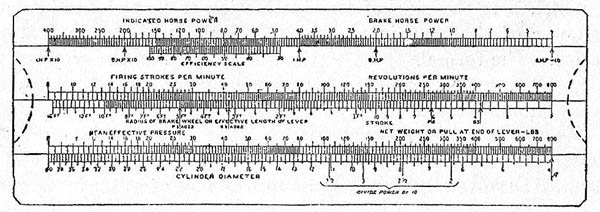
Figure 9, Pickworth’s Engine Power Computer
Conclusions
J G Hudson CE designed four calculating scales that were made and sold by W F Stanley. The Horse Power Computing Scale was also sold by Keuffel & Esser in the USA, for whom it was made by W F Stanley, and by A G Thornton.
The Horse Power Computing Scale was made for longer than the others (at least from 1878 to 1931) and, appears to have been the most popular. Ivory was replaced by opaque celluloid sometime between 1900 and 1912.
The Horse Power, Pump Duty, and Shaft Beam & Girder scales were all made in cardboard for a period of time before they were made in boxwood and other materials. These scales were available from at least 1890 to 1918.
The Photo Exposure Scale is only known from the 1900 and 1903 editions of Pickworth.
Examples of the HP and Pump scales exist in materials that have not so far been seen in the catalogues.
Acknowledgements
I am indebted o the following people for their help in producing this paper: Clark McCoy for providing the scans by Michael O’Leary, and for the information on his web site; Ray Hems for providing the scans of his ivory horse power computing scale; David Rance for pages from the 1924 W F Stanley catalogue; and last but not least, Peter Hopp for a page from Stanley’s 1898 catalogue and much other information. It would not have been possible without their assistance and support.
The Horse Power Computing Scale was made for longer than the others (at least from 1878 to 1931) and, appears to have been the most popular. Ivory was replaced by opaque celluloid sometime between 1900 and 1912.
The Horse Power, Pump Duty, and Shaft Beam & Girder scales were all made in cardboard for a period of time before they were made in boxwood and other materials. These scales were available from at least 1890 to 1918.
The Photo Exposure Scale is only known from the 1900 and 1903 editions of Pickworth.
Examples of the HP and Pump scales exist in materials that have not so far been seen in the catalogues.
Acknowledgements
I am indebted o the following people for their help in producing this paper: Clark McCoy for providing the scans by Michael O’Leary, and for the information on his web site; Ray Hems for providing the scans of his ivory horse power computing scale; David Rance for pages from the 1924 W F Stanley catalogue; and last but not least, Peter Hopp for a page from Stanley’s 1898 catalogue and much other information. It would not have been possible without their assistance and support.
References
1. W F Stanley & Co Ltd, Stanley’s Drawing Instruments, 1912 (catalogue)
2 Peter M Hopp, Slide Rules, Their History, Models, and Makers, Astragal Press, 1999
3. C N Pickworth, The Slide Rule A Practical Manual, Emmott & Co, 1903
4 W F Stanley, Surveying & Levelling Instruments, E & F N Spon, 1890
5. W F Stanley, Mathematical Drawing Instruments, E & F N Spon, 1900
6. W F Stanley, Mathematical Drawing Instruments, E & F N Spon, 1888
2 Peter M Hopp, Slide Rules, Their History, Models, and Makers, Astragal Press, 1999
3. C N Pickworth, The Slide Rule A Practical Manual, Emmott & Co, 1903
4 W F Stanley, Surveying & Levelling Instruments, E & F N Spon, 1890
5. W F Stanley, Mathematical Drawing Instruments, E & F N Spon, 1900
6. W F Stanley, Mathematical Drawing Instruments, E & F N Spon, 1888
7. A G Thornton Ltd, Drawing Surveying & Scientific Instruments and Drawing Office Materials, 1916 (Catalogue)
8. W F Stanley, Mathematical Drawing Instruments, E & F N Spon, 1878
9 Clark McCoy’s K&E Catalogue web pages
http://www.mccoys-kecatalogs.com/KEModels/ke4141family,htm
10. W F Stanley & Co Ltd, 1931 catalogue
11. Catalogue of Keuffel & Esser Co., New York, 1913
9 Clark McCoy’s K&E Catalogue web pages
http://www.mccoys-
10. W F Stanley & Co Ltd, 1931 catalogue
11. Catalogue of Keuffel & Esser Co., New York, 1913
Pages from the 1898 and 1924 W F Stanley catalogues were also consulted, as were other editions of C N Pickworth, The Slide Rule.









